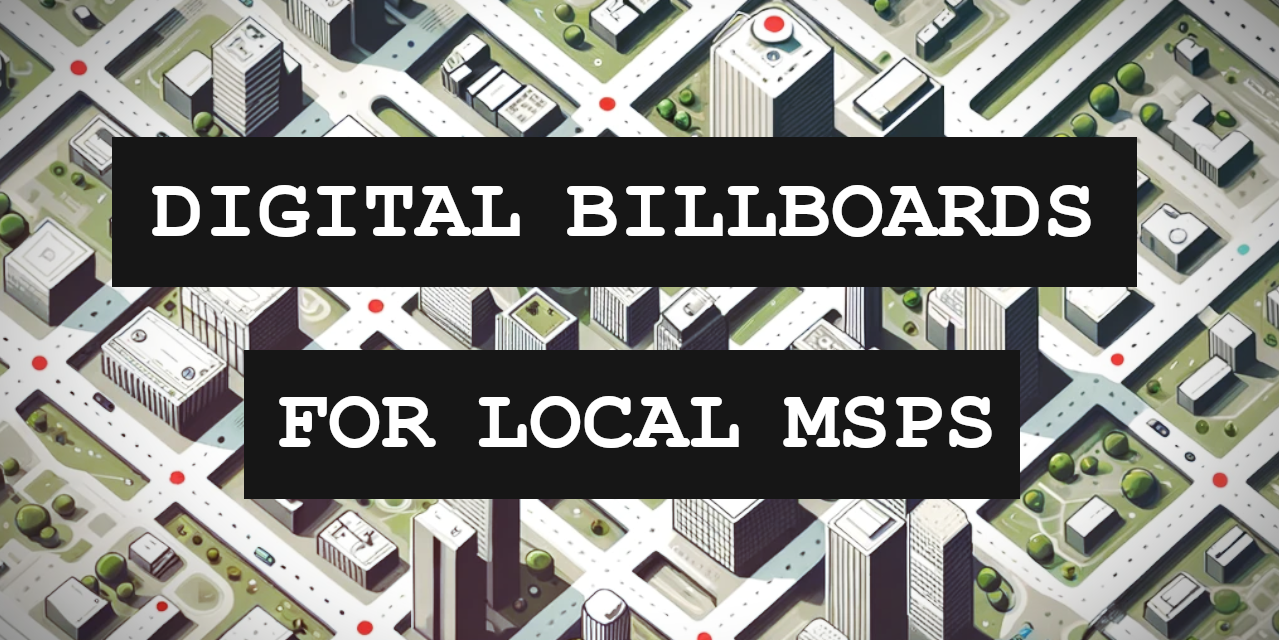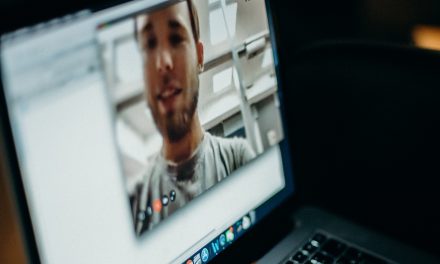Believe it or not, I started writing this article in the summer of 2022. At that time, Google began teasing their entry into the digital billboard space via their platform Display & Video 360 and it seemed like the comeback was on for “Out-Of-Home” (OOH) ads as they are typically called. The reason I never finished the article back then was because, while the idea was interesting, it just wasn’t practical yet. Inventory was somewhat minimal and I couldn’t imagine the majority of MSPs buying these ads this way after trying it myself.
So why now? I was staying at a hotel in the NJ-NYC Metro area a few weeks ago and needed to use the ATM. The machine was placed in a small cut-out in the corner of the lobby with a roughly 32’ inch TV mounted directly above it. By some incredible stroke of luck, on the screen in front of me flashed an ad for a local MSP. It was a fairly generic ad, but I could tell it was thoughtfully placed, given that this particular hotel was mostly for business travel. It struck me like a lightning bolt and I realized that it was time that I revisit this topic and see how these tools have evolved since my last attempt.
Digital Out-of-Home Ads
As you can imagine, digitizing traditional billboards offers no shortage of advantages. In the most obvious sense, launching a new ad doesn’t require a literal construction project to erect it. When it comes to ad specifications, a digital image or video is all that is required and in most cases it can exist in the same filetype that you would use on the web.
As DOOH matures, we are also seeing it transition from traditional large billboard placements on the side of highways to a diverse mix of locations and display devices. These locations may include, but are not limited to:
- Gas Stations
- Airports
- Stadiums
- Shopping Malls
- Bars & Restaurants
- Hotels
- Grocery Stores
- Elevators
- Bus Stops
Just about anywhere that you would find a human idle or moving through seems to be fair game for placements. The hotel lobby that I mentioned earlier is a prime example of this. In that case, it was shown on a TV that you could buy anywhere, however some placements such as gas stations and grocery checkouts appear to exist on special hardware and mounting devices. As a consumer, I have certainly noticed an increase in these DOOH ads, but I feel as though I am more sensitive to this than most. I don’t feel as though it has reached a point of complete saturation, which means there is certainly more room for this network to grow.
The Ultimate Guide To Cash Flow For Managed Services
Sponsored by Alternative Payments & Zest
Contextual Ad Creative
Now that you have an idea of what’s happening, let’s dig into why this is valuable and how to use it to your advantage. Imagine this scenario. You are a Illinois based MSP who has a vertical specialization in Law firms. There is a Legal industry conference being held at the Hyatt Regency Chicago. Lawyers and legal industry Executives from all over the country will be congregating in this location for one week. They will all be flying into the same airport, and most will be staying at the same hotel. Sure, you can buck up tens of thousands of dollars to sponsor the conference, but that will likely just make you a part of the noise.
What if instead you made strategic and clever placements within a close proximity to the venue but in a place that won’t compete with other vendor sponsors? This could be in the hotel elevator, above the local ATMs, a nearby parking garage, the bus stop on the corner, etc. And what if the ads themselves made reference to the conference, ie “Hey Lawyers! If you’re here, who’s keeping your business up and running?” This type of contextual ad creative has a way of pleasantly surprising viewers, especially those who relate to the context. It becomes almost shocking that they would stumble on an ad so relevant to them, but in such an unassuming place. This serendipity is what the modern form of digital out-of-home ads look to create.
Online / Offline Virality
The best part about this new evolution of digital marketing is that you are able to integrate these campaigns more seamlessly into online efforts and sometimes even generate organic social media impressions from offline ads. For example, you or a random viewer of your ad might snap a picture of it out in the wild and share it on social media. The more creative the ad and contextual the placement, the more likely this is to happen.
This is not all that different from the “fast-vertising” trend that took the world by storm a few years ago, where brands would create paid ads that were so relevant to current events (within days) that they would go viral. The common theme here is that the ad is shockingly relevant. This relevance could be in relation to the individual, place, time, weather, current events, or a combination of these. The higher degree of this relevance, the more likely the ad is to make its way online and generate organic impressions.
Inventory & Bidding Platforms
While the traditional way to buy billboard space was a very manual process, digital out-of-home ads are becoming increasingly easier to purchase. Not only are the platforms becoming more sophisticated and easy-to-use over time, but the inventory of placements appears to also be growing. This is creating an emerging marketplace of publishers and advertisers, much like in the early days of internet display ads when Google Adsense and Adwords established its dominance. While digital out-of-home ads are not new, it would appear as though it has finally reached a point where it can bring in digital-first advertisers into the network that otherwise would not have participated.
The platforms with access to the most inventory right now appear to be Google Display & Video 360, AdQuick, SmartyAds, and Blip. Nearly all of these platforms have very convenient, map-based discovery tools that allow you to locate, plan and request placements. The placements themselves are sourced from third-party media publishers and thus using the platform with the best tech and most inventory will likely yield the best results. The following is a screenshot from Adquick, detailing the available placements around the Hyatt Regency hotel, which I used in my previous example:

I think what I found to be most surprising in my research was the sheer number of non-roadside placements that were available. You expect to see ads while driving along a busy highway, but it appears that there are just as many, if not more placements inside of private businesses. For example, this placement below would allow you to run a 1920 x 1080 ad on a TV behind a bar in downtown Chicago.

If you think about it, this makes complete sense for high-traffic businesses that are looking to passively monetize their operations. I imagine as more advertisers start to flock to these networks and bid up placements, we will see even more non-traditional inventory get created.
The Ultimate Guide To Cash Flow For Managed Services
Sponsored by Alternative Payments & Zest
Programmatic Scheduling
The part that I get excited about the most is the ability to connect external data sources to DOOH that will trigger specific ads in designated locations. This is already happening now, as you might see an ad for hot coffee triggered when the temperature is below a certain degree and or an ad for iced coffee when the temperature is above. In this case, the data source is the temperature.
Using that same weather data feed, an MSP could also trigger ads that prepare viewers for upcoming winter storms or hurricanes in the forecast. These events often lead to blackouts, network outages, or even flood damage which can help drive demand for redundant systems, disaster recovery and network upgrades. While not every person who sees the ad is likely to be affected, a small percentage will have that serendipitous feeling and choose to act on it.
Impression Data & Reporting
Let’s not forget, attribution was the primary driver that led the transition from offline to online advertising. In the world of physical ads, there is a very long feedback loop to determine the ROI on the campaign and in many cases it is impossible to track. When suddenly you only had to pay when an ad is clicked and could directly track leads or purchases as a result, the risk became lower and ad budgets started to flow in.
I believe that this is the next frontier for DOOH and AI is probably the solution. Since you are paying for impressions, you want to guarantee that those impressions actually happen, which is why having a camera built into the display that can detect people becomes incredibly valuable for advertisers. I can even see the software using some form of eye tracking to determine what percentage of passersby actually look at the ad. In this case, advertisers would be able to determine how “eye-catching” their creative is compared to other ads and determine its effectiveness.
Conclusion
While I think that DOOH is still in its awkward transition from a legacy business model to one more akin to the digital ad networks, there is no doubt some opportunities to be had. For some reason “having a billboard” is like a badge of trust and can generate brand impressions that are more heavily-weighted than online ads. I am sure that this will wear off as it becomes more commonplace, but for now there is a ton of brand value up for the taking.

SPONSORED BY ZEST

















